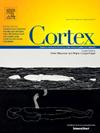Balancing act: A neural trade-off between coherence and creativity in spontaneous speech
IF 3.2
2区 心理学
Q1 BEHAVIORAL SCIENCES
引用次数: 0
Abstract
Effective communication involves a delicate balance between generating novel, engaging content and maintaining a coherent narrative. The neural mechanisms underlying this balance between coherence and creativity in discourse production remain unexplored. The aim of the current study was to investigate the relationship between coherence and creativity in spontaneous speech, with a specific focus on the interaction among three key neural networks: the Default Mode Network, Multiple-Demand Network, and the Semantic Control Network. To this end, we conducted a two-part analysis. At the behavioural level, we analysed speech samples produced in response to topic cues, computing measures of global coherence (indexing the degree of connectedness to the main topic) and Divergent Semantic Integration (DSI; reflecting the diversity of ideas incorporated in the narrative). Coherence and divergence in speech were negatively correlated, suggesting a trade-off between maintaining a coherent narrative structure and incorporating creative elements. At the neural level, higher global coherence was associated with greater activation in the Multiple-Demand Network, emphasising its role in organising and sustaining logical flow in discourse production. In contrast, functional connectivity analyses demonstrated that higher DSI was related to greater coupling between the Default Mode and Multiple-Demand Networks, suggesting that creative speech relies on a dynamic interplay between associative and executive processes. These results provide new insights into the cognitive and neural processes underpinning spontaneous speech production, highlighting the complex interplay between different brain networks in managing competing demands of being coherent and creative.
平衡行为:自发性言语中连贯性和创造性之间的神经平衡
有效的沟通需要在创造新颖、吸引人的内容和保持连贯的叙述之间取得微妙的平衡。在话语生产中,连贯性和创造力之间的平衡背后的神经机制仍未被探索。本研究旨在探讨自发性言语的连贯性与创造力之间的关系,并特别关注三个关键神经网络:默认模式网络、多需求网络和语义控制网络之间的相互作用。为此,我们进行了两部分的分析。在行为层面,我们分析了响应主题线索而产生的语音样本,计算了全局一致性(索引与主题的连接程度)和发散语义整合(DSI;反映了叙事中思想的多样性)。言语的连贯性和发散性呈负相关,这表明在保持连贯的叙事结构和融入创造性元素之间存在权衡。在神经层面上,更高的整体连贯性与多需求网络的更大激活有关,强调了其在话语生产中组织和维持逻辑流的作用。相反,功能连通性分析表明,较高的DSI与默认模式和多需求网络之间的耦合程度较高有关,这表明创造性言语依赖于联想过程和执行过程之间的动态相互作用。这些结果为支持自发语言产生的认知和神经过程提供了新的见解,突出了不同大脑网络在管理连贯和创造性的竞争需求方面的复杂相互作用。
本文章由计算机程序翻译,如有差异,请以英文原文为准。
求助全文
约1分钟内获得全文
求助全文
来源期刊

Cortex
医学-行为科学
CiteScore
7.00
自引率
5.60%
发文量
250
审稿时长
74 days
期刊介绍:
CORTEX is an international journal devoted to the study of cognition and of the relationship between the nervous system and mental processes, particularly as these are reflected in the behaviour of patients with acquired brain lesions, normal volunteers, children with typical and atypical development, and in the activation of brain regions and systems as recorded by functional neuroimaging techniques. It was founded in 1964 by Ennio De Renzi.
 求助内容:
求助内容: 应助结果提醒方式:
应助结果提醒方式:


